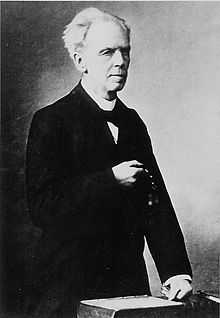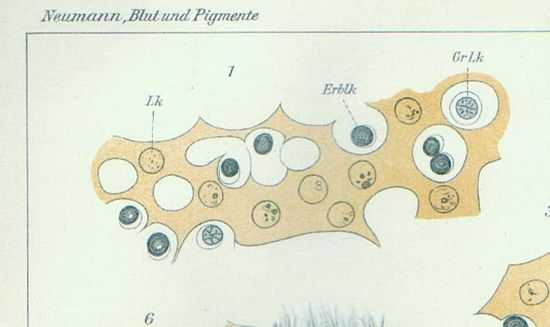Franz Ernst Christian Neumann
Franz Ernst Christian Neumann (January 30, 1834 - March 6, 1918) was a German pathologist who was a native of Königsberg. His common name was Ernst Christian Neumann (without Franz at the beginning).

Life
He was the son of physicist Franz Ernst Neumann (1798–1895), and grandson of chemist Karl Gottfried Hagen (1749–1829). He had two noted brothers, mathematician Carl Gottfried Neumann (1832–1925) and economist Friedrich Julius Neumann, see German version Wikipedia, (1835–1910).
In 1855 he obtained his doctorate from Albertina Universität Königsberg, where one of his instructors was Hermann von Helmholtz. He performed post-graduate studies in Prague, and in Berlin under Rudolf Virchow (1821–1902). From 1866 until 1903 he was in charge of the Pathological Institute at Konigsberg. Neumann was awarded honorary degrees from the Universities of Tübingen (1898) and Geneva (1914). In 1995, the first International Ernst Neumann Award has been initiated by the 24.Meeting of "International Society for Experimental Hematology in Düsseldorf/ Germany. The first recipient of this award was Donald Medcalf from Melbourne ([1] )
Scientific career
Ernst Neumann made many contributions in the field of hematology. He demonstrated that erythropoiesis and leukopoiesis formulate in the bone marrow. “Ernst Neumann postulated a common stem cell for all hematopoietic cells” (Brittinger, 1995). In 2007, Zech et al. wrote: “The beginning of Stem Cell research can be dated back to Ernst Neumann, who was appointed professor of pathology at Koenigsberg in 1866 and described in a preliminary communication the presence of nucleated red blood cells in bone marrow (BM) saps. He concluded in his subsequent papers, that during postembryonic life, erythropoiesis and leukopoiesis are taking place in the BM. On the basis of his observation, Ernst Neumann was the first to postulate the BM as blood forming organ with a common SC for all hematopoietic cells” (Zech,N.H., Shkumatov, A. Koestenbauer,S., 2007)
"Among his "firsts" were the identification of leukemia and of pernicious anemia as diceases of the marrow. He coined the term myelogeneous leukemia, (today's acute myeloid leukemia), and described in 1882 the law of dissemination concerning yellow and red bone marrow. In effect, he recognized a phenomenon that is sometimes referred to us as Neumann's law. It states that at birth all bones that contain marrow contain red marrow. With age, the blood producing activity contracts toward the center of the body, leaving the more peripheral bones with only fatty marrow. Neumann was supported by Giulio Bizzozero and by Claude Bernard, but there were also Pouchet and Georges Hayem to repudiate him. Despite all the opposition, however, within two decades, Neumann's discovery was a scientific axiom! The brilliance of the truth may first be blinding, but ultimately it supersedes all artificial illuminators" (Tavassoli 1983, p. 62 - 72)
In 1871, Neumann described congenital epulis (CE) of the newborn. Neumann also published an early work on medical electrodiagnosis and formed the name "Hämosiderin" as hematological pigment.
History of Stem-Cell

Legend of the stem cell-picture: Draft by Ernst Neumann himself, showing the “great-lymphozyt-stem-cell” (1912) or “great-lymphocyt” as stem cell for the postembryonic and embryonic development of erythropoiesis and leukopoiesis in the bone marrow and, as shown here, in the embryonic liver; GrLK: nucleus of great-lymphocyt-stem-cell; Erblk: Erythroblast; (Neumann 1914).
In 1868, Neumann described the "lymphoid marrow cell" (Neumann: Blood and Pigments 1917(BP), S.33) in the bone marrow. "It is evident, that a continuing transformation of lymphoid cells into coloured blood cells takes place in the bone marrow during the whole life" Neumann 1869, BP, p. 19. This "lympoid marrow cell" forms not only the erythropoiesis but it is capable (in itself) to self regeneration: “In order of the size differences of the lymphoid marrow-cells, we will be able to suppose that a permanent fluctuation will take place in the bone marrow" (Neumann 1869, BP p. 30). 1912: Until 1912 Neumann called the stem cell "lymphocyte", "great lymphocyte" or "lymphomyeloblast". Since that time, he declared: "The different forms of all blood cells happening in the blood, the lymph-organs and in the bone marrow are all descendants of the great-lymphocytic stem cell." (BP, page 313). "In which way this stem cell completes itself again and again, whether exclusively by a mitotic division or also from other cells particularly from cells of the mesenteric tissue, may be discussed." (Neumann, BP p. 313) Neumann was advocate of the Unitarien Point of View: All blood cells shall be descended from this post embryonic stem cell. As it is well known, a quarrel broke out between dualists and unitarians (Paul Ehrlich). Neumann's farsightedness demanded a stem cell culture for the completion of the quarrel: "Perhaps a final decision will only arrive, if it possible, to isolate the individual colourless cells and to study its life events in vitro culture for some time, as Robert Koch demonstrated with the bacteria" (Neumann 1912, BP, p. 329, see also References: H. Neumann and Y. Klinger)
Associated eponyms
- Neumann's cells: Nucleated cells in the bone marrow in which red blood corpuscles originate.
- Neumann's sheath: Dentinal sheath which form the walls of the dentinal tubules.
- Rouget-Neumann sheath: Uncalcified bone matrix between an osteocyte and the lacunar or canalicular wall. Named with French physiologist Charles Rouget (1824–1904).
- Neumann tumour: Congenital epulis.
- Neumann's law: see above
References
"Despite the intensity of the search, Neumanns observations did not catch on easily. Neumann was supported by G. Bizzozero and by Claude Bernard, but there were also Pouchet and Hayem to repudiate him."(Tavassoli 1983, p. 62 - 72)
- Askanazy, M.: Ernst Neumann; Zbl. f. Allg. Path. u. Path. Anatomie 29 (1918), S.409-421 und Verh. dt. Path. Ges. 28 (1935), S. 363-372 (contains a list of all publications of Ernst Neumann)
- Brittinger, G. Life and work of Ernst Neumann. Manuskript Festvortrag zur Verleihung des Ernst Neumann-Award 1995 in Düsseldorf (ask Neumann-Meding)
- Buzmann, C.:Der Pathologe Ernst Neumann und seine Forschung auf dem Gebiet der Degeneration und Regeneration periferer Nerven nach Kontinuitätstrennung. Dissertation, Medizinische Hochschule Hannover August 2003.
- Dinser, Ricarda: Der Beitrag Artur Pappenheims zur Hämatologie um die Jahrhundertwende Inaugural-Dissertation zur Erlangung des Doktorgrades der Medizin einer Hohen Medizinischen Fakultät der Ruhr-Universität Bochum 2001.
- Klinger, Y. : Über die Entdeckung der hämatopoetischen Funktion des Knochenmarks und das Postulat der Stammzelle. Von der Hypothese Ernst Neumanns zum experim. Beweis. Inaug.-Dissertation Bochum 1992
- Kühböck, J.: Hundert Jahre funktionelle Morphologie des Knochenmarks: Zur Erinnerung an Ernst Neumann, Clio medica, Vol.4, (1969), S.121-125 (nach Vol.4: Pergamon Press, Printed in GB).
- Lawrynovicz, K. Albertina. 1. Ausgabe in russ. Sprache: Otscherki istorii Kenigsbergskogo universiteta. K 450-letiju so wremieni osnawanija 1995 Erweiterte deutsche Ausgabe: Der Göttinger Arbeitskreis: Veröff. Nr.495 Dunker und Humblot, 1999
- Neumann, H.A.;Klinger,Y.: Knochenmark und Stammzelle. Der Kampf um die Grundlagen der Hämatologie. Ex libris Roche Bd.1 Blackwell Verlag Berlin 1994
- Neumann-Redlin von Meding, E.: Der Pathologe Ernst Neumann und sein Beitrag zur Begründung der Hämatologie im 19. Jahrhundert. Schriftenreihe der Münchner Vereinigung für Geschichte der Medizin e.V. Bd. Nr.18 Demeter Verlag München 1987 (contains a list of all publications of Ernst Neumann)
- Neumann-Redlin von Meding, E: Ernst Chr. Neumann (1834–1918); Die Beschreibung der funktionellen Morphologie des Knochenmarks am Pathologischen Institut Königsberg und dessen Einfluß auf die Hämatolgie des 19.Jahrhunderts. in: Jahrbuch der Albertus Univ. Königsbg. Bd.29 (1994)425-437) Hrsg. Rauchning,D. et al. in: Die Albertus Universität zu Königsberg und ihre Professoren. Duncker u.Humblot Berlin
- Neumann-Redlin von Meding,E.: 130 Jahre Zytologi(e)´sches Fundament der modernen Hämatologie des 19.Jahrhunderts(Ernst Neumann). Verhandl. Schweiz./Deutsch/Österr. Gesell.f. Zytologie Jahrestag 2001 Flims. Urban u. Fischer München/Jena S. 101-105 (with quotations of Wintrobe, Tavassoli in English)
- Pappenheim, A. : Einladung zu einem 1. Hämatologenkongress Berlin 1910. Folia haematologica, Bd. 9 (1910) 98-99
- Rosenow, G. : Ernst Neumann. His Significance in Today's Hematology. Karger Gazette Basel Nr. 15 (1967) 8
- Tavassoli, M. : Bone Marrow: The Seebed of Blood: aus Wintrobe,M.M: Blood, pure and eloquent sh.5; Mc.Graw-Hill Book Company 1980and: Bone Marrow. Structure and Funktion. Alan R.Liss. Inc. New York, 1983
- Wintrobe, M. : Hematology, the Blossoming of a Science; a Story of Inspiration and Effort. Lea & Febiger Philadelphia 1985
- Zech,N.H., Shkumatov, A. Koestenbauer,S: Die magic behind stem cells. Journal of Assisted Reproduction and Genetics Vo. 24, Nr. 6 (2007) 208 - 214
Literature
Bibliography of Ernst Neumann: (another picture of the famous stem cell look at the German version of Wikipedia: Ernst Christian Neumann, see Link
- Neumann, E.: Beiträge zur Kenntniss des Zahnbein- und Knochengewebes. Leipzig, 1863.
- Neumann, E.: Ueber das verschiedene Verhaltung gelähmter Muskeln gegen den constanten und inducirten Strom und die Erklärung desselben. Deutsche Klinik, Berlin, 1864, 16: 65-69 (One of the first publications on electrodiagnosis).
- Neumann, E.: Über die Bedeutung des Knochenmarks für die Blutbildung, Centralblatt für die Med. Wissenschaft 44 (1868) 689
- Neumann, E.: Über die Bedeutung des Knochenmarks f.d. Blutbildung, Ein Beitrag zur Entwicklungsgesch. der Blutkörperchen, Archiv f. Heilkunde 10 (1869) 68-102 (Wagners Archiv)
- Neumann, E.: Ein Fall von Leukämie mit Erkrankung des Knochenmarks Anhang: Salkowski: Chemische Untersuchungen des leukämischen Markes (28.7.69)Archiv der Heilkunde (Wagners Archiv) Bd. XI, (1871) 1 - 15
- Neumann, E.: Das Gesetz über die Verbreitung des gelben und rotten Knochenmarks, Centralblatt für die Med. Wissenschaft. 18 (1882) 321-323
- Neumann, E.: Hämatologische Studien I: Über die Blutbildung beim Frosche, Virchows Archiv 143 (1896) 225 - 277
- Neumann, E.: Hämatologische Studien II. die Variabilität der Leukozyten etc., Virchow Archiv 207 (1903) 41 - 78
- Neumann, E.: Hämatologische Studien III. Leukozyten und Leukämie, Virch. Arch. 207 (1912) 379-412
- Neumann, E.: Neuer Beitrag zur Kenntnis der embryonalen Leber, Arch.f.mikr. Anat 85,Abt.I (1914) 480-520
- Neumann, E.: Blut und Pigmente (BP). Gesammelte Abhandlungen mit Zusätzen, Fischer, G. Jena 1917, contains all publications of Neumann with reference to hematology and pigments.
External links
- Homepage in English in regard to Ernst Neumann
- See German version of Wikipedia de:Ernst Neumann
- Der Wissenschaftler Ernst Christian Neumann, Pathologe und Hämatologe, Königsberg
- Bauer, A.: International Bibliographic Guide to the History of Pathology (IBGHP) (
- Franz Ernst Christian Neumann @ Who Named It
|